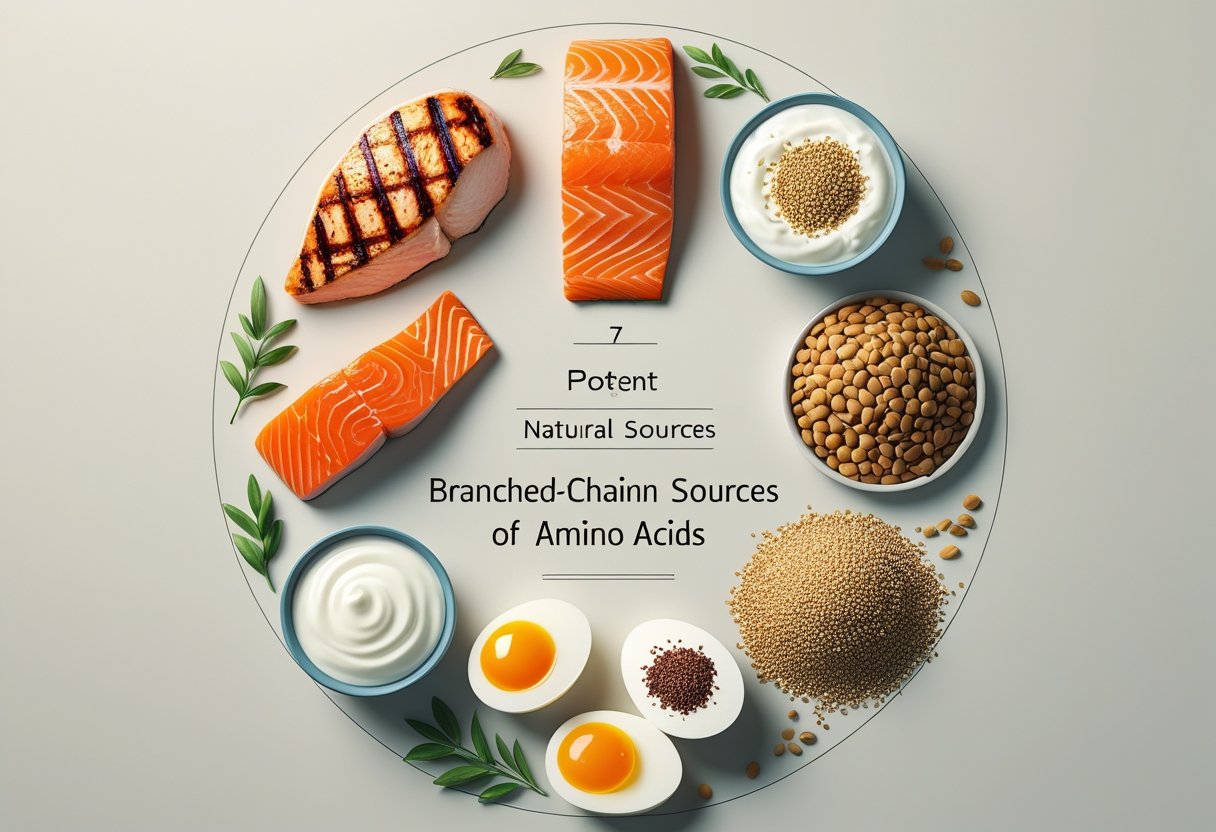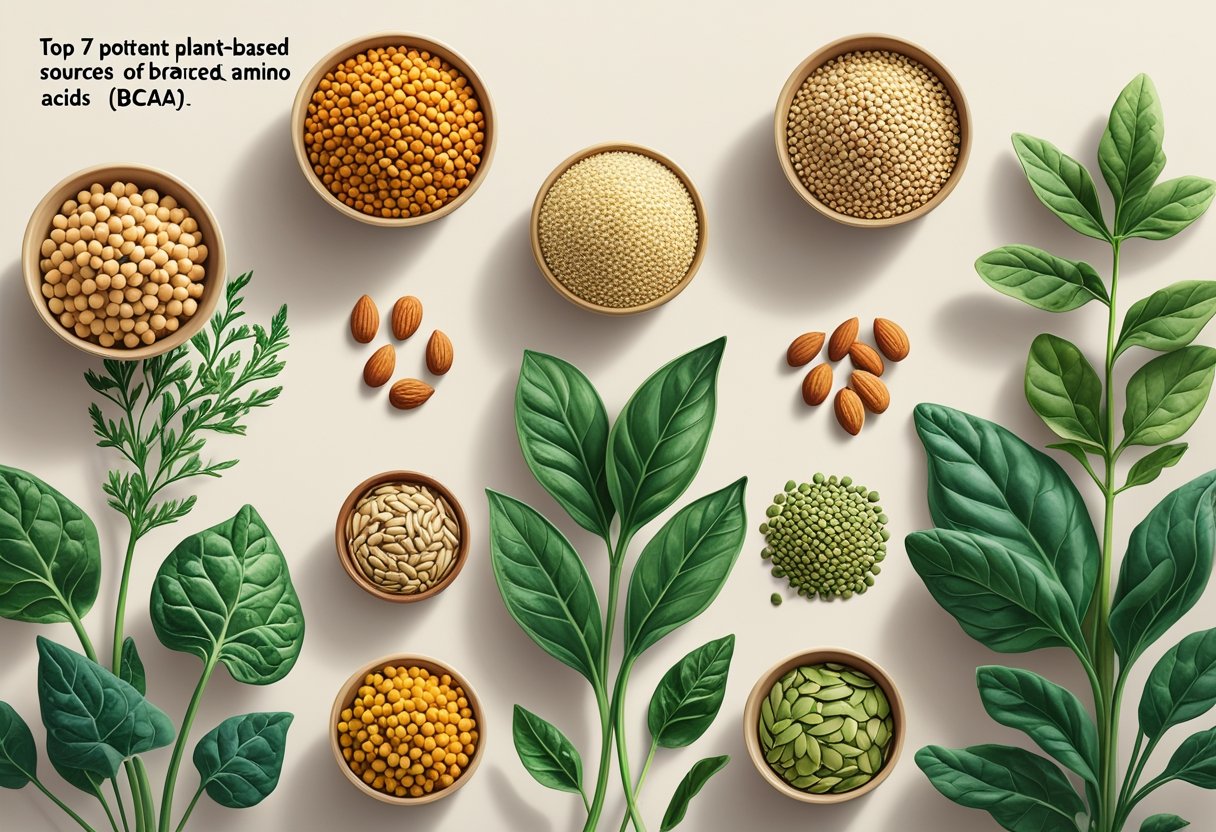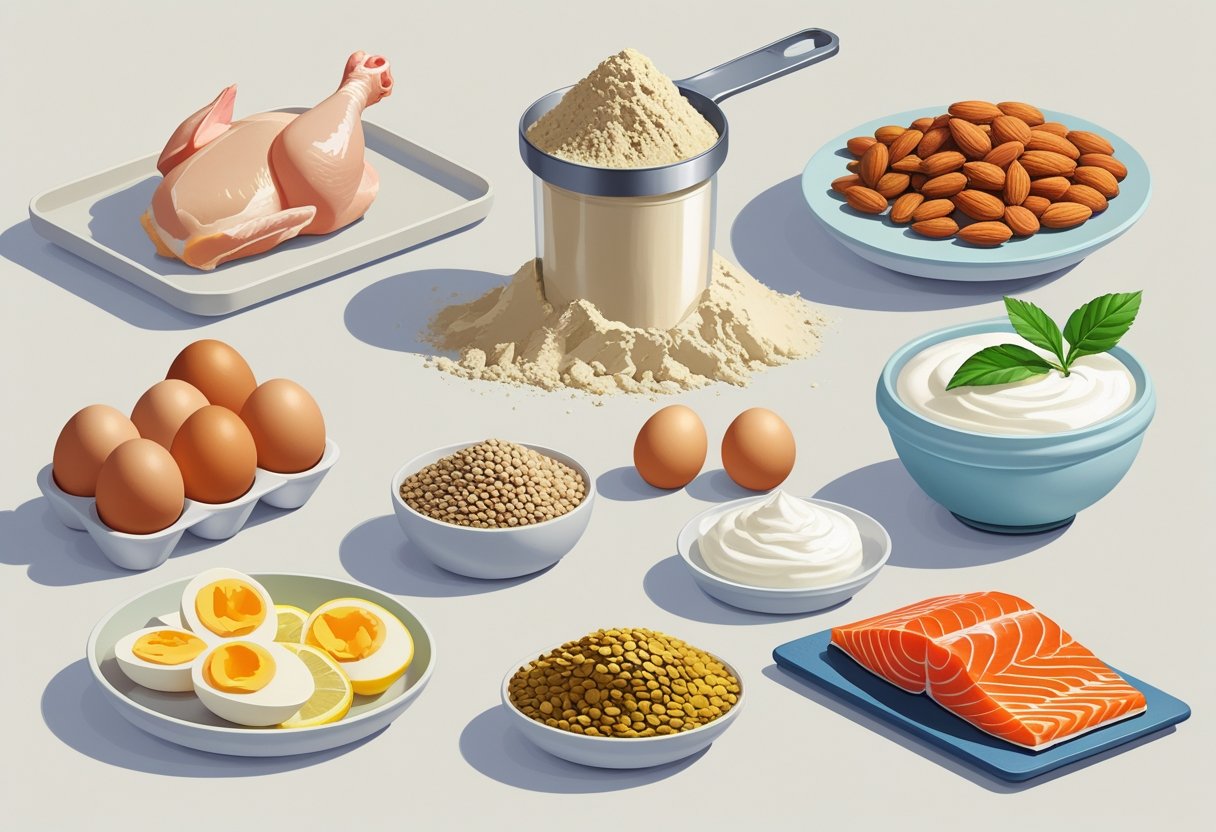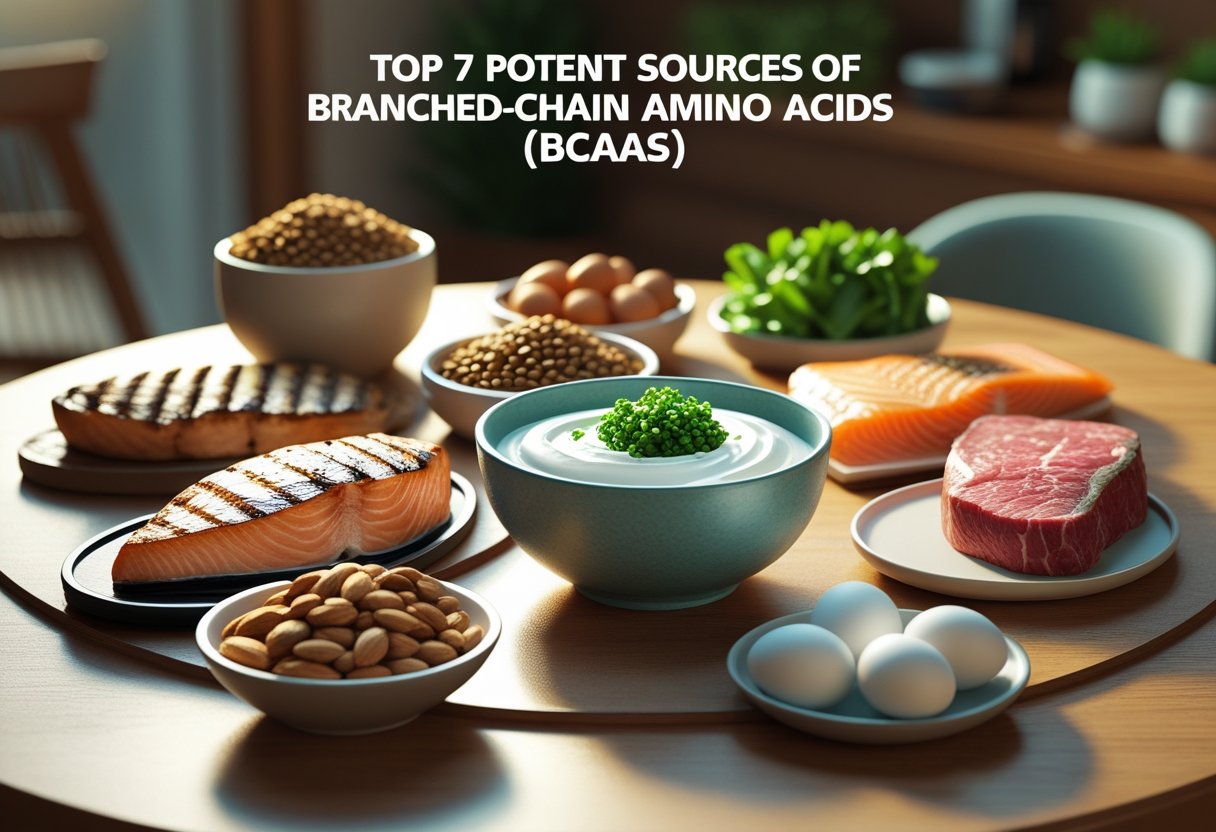Branched-chain amino acids (BCAAs) are a special group of amino acids that play an important role in building muscle and supporting recovery after exercise. The best natural sources of BCAAs include animal proteins like eggs, chicken, and turkey, as well as plant-based options such as beans, seeds, and nuts. Whether someone follows a vegetarian diet or eats meat, there are effective ways to get enough BCAAs through food.

BCAAs are popular among athletes, but anyone can benefit from including them in their meals, because they help support muscle growth and keep energy levels steady. Learning about food sources that are high in BCAAs helps people make smart choices to support their health and fitness goals.
Key Takeaways
- BCAAs are important for muscle support and recovery.
- Both animal and plant foods provide BCAAs.
- Eating a BCAA-rich diet can benefit health and fitness.
What Are Branched-Chain Amino Acids (BCAAs)?
Branched-chain amino acids, or BCAAs, are essential nutrients for the human body. These amino acids are important for both muscle tissue health and various metabolic functions.
Structure and Types of BCAAs
BCAAs are called “branched-chain” because they have a unique chemical structure with a branch on their side chain. This branch is made of a central carbon atom connected to at least three other carbon atoms.
The three BCAAs are leucine, isoleucine, and valine. They are part of a group known as essential amino acids, which means the body cannot make them on its own.
Each of these BCAAs has a specific job in the body. Leucine is mainly known for helping with protein synthesis and muscle growth. Isoleucine supports energy production and regulates blood sugar. Valine plays a role in muscle repair and energy during exercise.
People usually get BCAAs from protein-rich foods like meat, eggs, and dairy. Supplements are also popular, especially for athletes. More on their unique structure can be found on the Wikipedia page about BCAAs.
Role of BCAAs in the Body
BCAAs support muscle protein synthesis, making them important for muscle repair and growth after exercise. Leucine, in particular, plays a key role in starting this building process.
During exercise or long periods without food, the body can use BCAAs as an energy source. This helps prevent muscles from breaking down to produce energy.
BCAAs are also involved in important metabolic and anabolic processes. These processes help the body build new tissues and create energy from nutrients. BCAAs are especially vital for people recovering from injuries or those trying to increase muscle mass.
The body cannot make these essential amino acids, so it needs to get them from diet or supplements. Foods like eggs, meat, and dairy are good sources. For more details, see the Healthline guide on BCAA benefits.
Benefits of BCAAs for Health and Performance
Branched-chain amino acids, or BCAAs, play an important role in building and repairing muscle tissue. They also support energy during workouts and help the body recover after exercise.
Muscle Growth and Recovery
BCAAs help the body with muscle protein synthesis, which is the process that builds new muscle. Leucine, one of the main BCAAs, is especially important for this job. When protein synthesis is higher than muscle breakdown, the muscle gains strength and size.
After tough workouts, muscles can feel sore and tired. Studies show BCAA supplements can reduce muscle soreness and help muscles recover faster by lowering damage in muscle fibers.
BCAAs may also help prevent muscle loss, which is important for both athletes and people with health problems that affect muscles. People who eat enough BCAAs tend to keep their muscle mass better during periods of rest or illness. Learn more about how BCAAs support muscle growth and recovery.
Exercise Performance and Endurance
During hard exercise, muscles use BCAAs for energy. This can delay tiredness and help a person keep training longer. Many athletes take BCAAs to help improve their workout performance, especially in activities that take a lot of endurance or repeated bursts of effort like running or cycling.
Research shows that BCAAs might lower feelings of fatigue by changing levels of certain chemicals in the brain. This could help people maintain focus and strength during intense sessions. Exercise performance and endurance may improve in both short, intense sports and longer endurance workouts.
Some athletes also find that taking BCAAs before workouts supports faster recovery and feels less exhausting, which means they can train more often and keep up their progress.
Animal-Based Sources of BCAAs
Animal foods are some of the highest sources of branched-chain amino acids. Meat, dairy products, and eggs deliver all three BCAAs—leucine, isoleucine, and valine—in large amounts as part of their protein content. Including these foods in the diet helps support muscle growth, recovery, and overall protein intake.
Meat and Poultry
Meat and poultry offer high levels of BCAAs. Beef, pork, chicken, and turkey are popular options, each one rich in complete protein. Just 3 ounces of chicken or turkey provide essential amino acids along with a high concentration of BCAAs, which help with muscle repair and maintenance.
Red meat, especially lean beef, has a substantial amount of l-leucine, which is key for muscle building. Both poultry and red meats supply all three BCAAs in a form that is easily absorbed by the body. Fish, such as salmon, is another quality source that gives protein as well as omega-3 fatty acids.
Choosing lean cuts of meat and skinless poultry helps lower saturated fat intake while still getting a large amount of branched-chain amino acids. Including a variety of animal proteins in meals supports balanced nutrition and steady BCAA levels.
Dairy Products
Dairy foods provide a high-quality, animal-based source of protein with a significant BCAA content. Milk, yogurt, and cheese are all good examples. A single cup of milk can supply 8 grams of protein, delivering BCAAs along with calcium and vitamin D.
Greek yogurt is especially rich in protein, with a thick texture and higher concentrations of leucine compared to regular yogurt. Hard cheeses like cheddar and parmesan also concentrate BCAAs due to the reduced water content. These products support muscle repair and are convenient options for both meals and snacks.
Many dairy foods also contain other nutrients like potassium and B vitamins that contribute to overall health. People who are lactose intolerant can choose lactose-free versions to still get the benefits of dairy protein and BCAAs.
Eggs
Eggs are among the most concentrated sources of complete protein, supplying every essential amino acid including a generous amount of BCAAs. Both the egg white and yolk provide high-quality protein, though egg whites have slightly more BCAAs per gram.
One large egg has about 6 grams of protein, which includes leucine, isoleucine, and valine. Eggs are also rich in vitamins and minerals like choline, selenium, and vitamin B12. They are versatile, easy to cook, and useful in a range of dishes.
For those who want more protein without extra fat, using more egg whites is an effective choice. Whole eggs, however, offer healthy fats and more nutrients, making them a balanced option for most diets.
Plant-Based Sources of BCAAs

Many plant foods supply branched-chain amino acids (BCAAs), which are important for muscle maintenance. Some options, like soy products, beans, and quinoa, also provide high-quality plant protein and key essential amino acids.
Soy Products
Soybeans and foods made from soy are among the richest plant-based dietary sources of BCAAs. Soy contains all nine essential amino acids, making it a complete protein. Products like tofu, tempeh, and edamame offer a large amount of protein per serving—typically about 10–19 grams per 100 grams, depending on the item.
Soy protein is easy for the body to use. It has a high amount of leucine, one of the main BCAAs that helps trigger muscle growth. Consuming soy foods can help vegans and vegetarians meet their daily requirements for amino acids and protein. According to several studies, soy protein is nearly as effective as animal proteins for muscle building and maintenance.
Soy-based protein powder is another option for those looking for a more concentrated BCAA source. Including soy in the diet can be as simple as adding tofu to stir-fries or blending soymilk into smoothies. For more, see these vegan sources of BCAAs and their effectiveness.
Legumes
Legumes are a key plant protein option rich in BCAAs. This group includes beans (like black beans, kidney beans, and pinto beans), lentils, chickpeas, and even peanuts. Many types of legumes supply about 7–9 grams of protein per half-cup cooked serving.
Peanuts and beans both have higher amounts of leucine and valine, two major BCAAs. Eating a variety of legumes improves the overall amino acid profile and ensures a more complete dietary intake. Besides BCAAs, legumes offer fiber, iron, and other nutrients important for health.
Peanuts, technically a legume, deliver a notable amount of essential amino acids. Including roasted peanuts or natural peanut butter in meals can help boost protein and BCAA intake. Learn more about the top foods high in leucine.
Quinoa
Quinoa is a unique plant because it contains all the essential amino acids, making it a “complete” protein. One cup of cooked quinoa has about 8 grams of protein. While its BCAA content is not as high as soy, it is still significant among grains.
Quinoa is especially helpful for those who want to diversify their sources of plant protein. It is gluten-free and easy to include in salads, bowls, or as a side dish. This grain not only adds BCAAs to meals but also delivers magnesium, fiber, and antioxidants.
Those looking to improve their amino acid intake from grains can benefit from adding quinoa to their diet. It is especially useful for those following plant-based diets as a versatile and nutritious protein source.
BCAA Supplements

BCAA supplements provide branched-chain amino acids in concentrated doses, making it easier for people to support muscle repair, especially after exercise. These supplements come in different forms and can have varying effects on absorption and energy levels.
Types and Forms of BCAA Supplements
BCAA supplements commonly include the three amino acids: L-leucine, isoleucine, and valine. They are usually offered as powders, capsules, or tablets.
Many protein powders also contain BCAA as part of their amino acid profile, but concentrated BCAA products allow for more targeted dosing. Flavored powders can be mixed with water, while capsules and tablets are easy to take on the go.
Consumers sometimes pick vegan or allergen-free options, including those with no added sugar or artificial ingredients. Some sellers online offer bulk deals and free shipping.
When comparing products, it helps to look for the precise dose of each amino acid. Some supplements list these separately, while others provide just the total BCAA content.
Efficacy and Absorption
BCAA supplements are popular for their potential to help with muscle repair and reduce soreness after exercise. The absorption rate depends on the form; powders may be absorbed more quickly than capsules due to faster digestion.
L-leucine is often seen as the most effective for triggering muscle protein synthesis. People usually take BCAA supplements before, during, or after workouts to support muscle health and maintain energy levels.
While many find them helpful, BCAA supplements do not replace whole food protein sources. Possible side effects include fatigue, stomach discomfort, or changes in blood sugar in rare cases. According to recent research, consistent use may lead to small improvements in recovery, but results can vary from person to person.
How to Incorporate BCAA-Rich Sources Into Your Diet
Getting enough BCAAs from food can help support muscle growth, recovery, and nitrogen balance. Both animal and plant proteins offer useful options for increasing BCAA intake as part of a balanced diet.
Daily Intake Recommendations
For those focused on muscle growth or recovery, aim to get 5–12 grams of BCAAs daily as part of your total protein intake. This range is enough to maintain nitrogen balance and support healthy body composition. It’s best to get BCAAs from whole foods, such as eggs, lean meat, dairy, and soy.
Try adding chicken breast, turkey, or Greek yogurt into lunches or dinners. A 3-ounce serving of poultry or beef provides about 5–7 grams of BCAAs. If you follow a plant-based diet, foods like tofu and edamame offer solid amounts—about 2–3 grams of BCAAs per cup. Adults with higher activity levels or heavy strength training may need to focus on the upper end of the suggested range.
Keep meals spaced evenly during the day to help your body use amino acids for muscle protein synthesis.
Combining Animal and Plant Sources
Mixing animal and plant proteins covers all essential amino acids and helps people with different preferences. Animal proteins, like egg, chicken, and dairy, are rich in BCAAs and can quickly boost intake. For those who eat meat, try rotating between chicken, fish, eggs, and lean beef.
If choosing plant protein sources, use foods such as soybeans, lentils, quinoa, and nuts. For example, a stir-fry with tofu and cashews or a salad topped with edamame gives a mix of protein and BCAAs. Athletes and vegetarians may benefit from combining both types at some meals. This strategy supports muscle recovery and delivers steady amino acid levels from various dietary sources.
Potential Risks and Side Effects
BCAA supplements are popular in fitness and health circles, but they can present some health risks if not taken correctly. Certain groups of people might face a higher risk of unwanted side effects or interactions, especially those with specific preexisting health issues or who use other nutritional supplements.
Overconsumption and Health Concerns
Taking high amounts of BCAA supplements can lead to unwanted side effects. These may include fatigue, loss of coordination, and stomach issues such as nausea or bloating. People with chronic illnesses, such as type 2 diabetes or heart disease, should be cautious, since BCAAs may affect blood sugar levels and metabolism.
Evidence suggests that taking too much may also contribute to problems linked to obesity and insulin resistance. A 2022 review found that a high intake of amino acid supplements, including BCAAs, is not risk-free and could cause harmful side effects. Anyone with existing health conditions should check with a healthcare professional before using BCAA supplements.
Interactions With Other Supplements
BCAA supplements can interact with other popular fitness and nutrition supplements. For example, combining BCAAs with creatine is common. While there is little evidence of severe negative effects from this mix, users should still watch for unexpected reactions.
Some supplements can impact how BCAAs are absorbed or used in the body. Taking multiple products at once increases the chance of side effects. People undergoing surgery or who have metabolic disorders should avoid mixing BCAA supplements with other products unless approved by a healthcare professional, as BCAAs may interfere with blood glucose levels before or after surgery.
Staying aware of potential interactions helps minimize risks. Always consider other supplements and medicines in use when choosing to add BCAAs.
Conclusion
BCAAs are essential amino acids that cannot be made by the body. They must come from dietary sources like meat, dairy, eggs, and some plant foods.
Including BCAA-rich foods may help with muscle growth and recovery after workouts. Research shows they can also reduce soreness and fatigue from exercise. For vegetarians, certain seeds, beans, and nuts are good plant-based options.
Supplements are available but many people can meet their needs through a balanced diet. Studies suggest that BCAAs can support muscle mass and performance, though results can vary from person to person.
Key Benefits of BCAAs:
- May promote muscle growth
- Can reduce muscle soreness
- May help with recovery from exercise
- Support essential body functions
Focusing on whole foods as sources of BCAAs can give the added benefit of other nutrients like protein, vitamins, and minerals. Supplements may be helpful for some, but they are not required for most people with a balanced diet.
Frequently Asked Questions
BCAAs are essential amino acids found in daily foods like meat, eggs, and legumes. People often want to know the specific sources, recommended amounts, possible side effects, and how to include BCAAs in their diet.
What are the top food sources rich in leucine for vegetarians?
Vegetarians can get leucine from foods like soybeans, lentils, chickpeas, and other legumes. Peanuts, tofu, and tempeh are also strong plant-based sources. Seeds like pumpkin and sunflower seeds contain notable amounts as well.
How much leucine is recommended daily for muscle building?
Research suggests that adults aiming to build muscle should get about 2–3 grams of leucine per meal. This amount is often enough to help stimulate muscle protein synthesis. Total daily needs may vary but are usually in the range of 5–10 grams per day.
Can you list the primary natural sources of BCAAs?
BCAAs are found in highest amounts in animal products like meat, poultry, and fish. Eggs, dairy, and some plant-based foods like beans and lentils also provide BCAAs. Foods such as peanuts and soy products are good sources for those who avoid meat, as shown by these findings.
What are the potential side effects of consuming BCAAs?
Some people report side effects like fatigue and loss of coordination when taking BCAA supplements. High doses can cause stomach discomfort or nausea. For most people, BCAAs in food are considered safe when eaten in typical amounts, but very high supplemental doses may pose health risks, according to medical experts.
How can one obtain BCAAs through a typical diet?
Eating a balanced diet with enough protein from foods like meat, dairy, eggs, and legumes provides enough BCAAs for most people. Those who follow vegetarian or vegan diets can focus on soy, beans, lentils, and nuts to meet their needs.
What is the BCAA content in an average serving of eggs?
One large egg has about 1.3 grams of BCAAs in total. Leucine, isoleucine, and valine are all present. Eggs are a convenient and affordable source of these essential amino acids.
Power up your nutrition—now explore more amino acid guides in the Amino Acids category.

